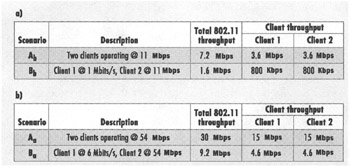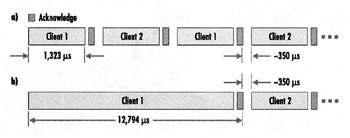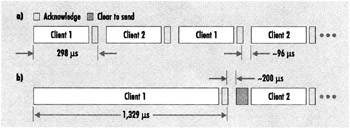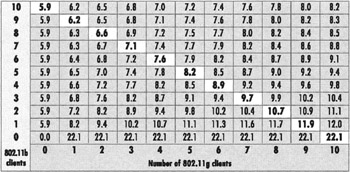The B G Networking Environment
|
| < Day Day Up > |
|
The "B" / "G" Networking Environment
Adding 802.11g to an existing 802.11b network presents some challenges. As you know, the 802.11g standard brings much higher data rates to the 2.4 GHz band. But what you may not realize is that data throughput rates can drop significantly when 802.11g devices are introduced into a legacy 802.11b network (or vice versa). Some readers also might not understand that such drops in throughput are common to any wireless network where high-rate and low-rate devices share the same medium. Finally, you need to know that 802.11g provides protection mechanisms to mitigate such issues.
To gain accurate insight into the mechanics that underlie 802.11g WLANs, it is necessary to examine its operation under homogeneous (802.11g-only) as well as mixed-mode operation in which an 802.11g client shares an access point with a legacy 802.11b client.
| Note | I want to thank CMP Media LLP and Menzo Wentink, Tim Godfrey and Jim Zyren, the authors of "Overcoming IEEE 802.11g's Interoperability Hurdles," published in the May 2003 issue of Communication Systems Design magazine, inasmuch as the following text and metrics relies heavily upon that article. |
The wireless networking is inherently more challenging than wired, especially since the effective range falls as data rate increases. For this reason, 802.11b computing devices (clients) located close to an AP can easily connect at 11 Mbps. However, these same devices will fall back to 5.5, then to 2, and finally to 1 Mbps data rates as the device moves further away from the AP, which causes the signal to weaken.
To understand this fall back process, consider two homogeneous 802.11b-only scenarios. In the first, scenario Ab of Fig. 10.8, an 802.11b AP is streaming large files downstream to two clients, each of which is proximal to the AP and operating at 11 Mbps. The second, scenario Bb, is similar to the first except one client/computing device has now roamed to the edge of the network and has fallen back to a data rate of one Mbps to preserve the network connection.

Figure 10.8: The effect of a roaming client is similar for both the 802.11b a) scenario, and b) scenario. The AP will alternate transmissions between Client 1 and Client 2, and network throughput will drop between 70 and 77 percent.
| Note | An AP and all of the associated clients are collectively referred to as a basic service set (BSS). Within any BSS, data can flow downstream (AP to computing devices), upstream (computing devices to AP) or in a bidirectional manner (combination of upstream and downstream traffic). Although every data packet is immediately followed by an acknowledgement frame (ACK) in the opposite direction (unless the packet is received in error), the direction of data flow refers to the direction of the data packet. Thus, downstream data flow refers to a packet exchange consisting of a downstream data packet followed by an upstream ACK. When considering the case of downstream traffic flows, it should be kept in mind that the network throughput is determined by the speed at which the AP can access the medium. |
When two computing devices are queued traffic at the AP, packets are on average sent to each device on an alternating basis since all 802.11 networks use a carrier sense-multiple-access/collision avoidance (CSMA/CA) channel-sharing scheme. As a result, before the AP can transmit, it must contend for access to the medium. In Fig. 10.9, "a" depicts Scenario Ab in Fig 10.8, in which a series of 1500-byte packets is being transmitted downstream from the AP to two clients at 11 Mbps.

Figure 10.9: When two clients (computing devices) are close to an AP (a), the data rates are similar. But, as Client 1 roams to the network edge (b), its rate drops quickly, slowing considerably the time taken for the packet transmit and ACK.
Note that each packet is followed by an ACK and a contention or "back-off" interval. Importantly, when the AP has queued traffic, data packets are sent to Client 1 and Client 2 on an alternating basis. Under the conditions depicted in Fig. 10.9 a, actual network throughput is about 7.2 Mbps. This does not include TCP/IP or Application Layer overhead. Therefore, if network throughput is measured by means of a large file transfer, results would be somewhat lower (more about this later).
Now consider Fig. 10. 8's Scenario Bb, which is an equally as plausible as that depicted in Fig. 10.9 b. Assume that Client 1 roams out to the edge of network coverage. In this condition, the AP would require a staggering 12,794 microseconds to transmit the same 1500-byte packet and receive the ensuing ACK from Client 1. The time required for the same exchange between the AP and Client 2 would remain unchanged at 1323 microseconds.
It is important to remember that for downstream traffic the AP will alternate transmissions between Client 1 and Client 2. From b in Fig. 10.9 it should be clear that Client 1 dominates airtime due to operation at 1 Mbps. As a result, network throughput falls from 7.2 Mbps in scenario Ab to just 1.6 Mbps in scenario Bb (Fig. 10.8). This represents a drop in network throughput of 77 percent. In this situation, network throughput is shared equally among clients. On an individual basis, each client will realize 800 Kbps effective throughput. The drop in throughput is not a result of a network problem. Rather, it is a completely predictable consequence of network operation in a mixed-rate environment.
That scenario is analogous to the conditions under which most 802.11g network tests are being conducted (downstream transfer of large packets). It is worth emphasizing that the 77 percent drop in network throughput is not due to any interoperability issue, nor has Client 2 reduced its data rate.
IEEE 802.11a networks will exhibit similar behavior, giving a 70 percent drop in total throughput (see Fig. 10.8, scenario b).
Up to this point, the scenarios have been relatively simple, consisting of only two clients/computing devices receiving downstream traffic from the AP. But a WLAN's throughput depends on several factors, including the relative amount of time devoted to operating at peak data rates as compared with the amount of time spent operating at lower rates. For situations involving many devices, network throughput depends on the number of high-speed devices relative to the number of slower devices.
Due to the fact that the operation of an 802.11g WLAN involves devices using different waveforms, the situation is slightly more complicated. However, the same basic dynamics are applicable. Let's consider 802.11g network behavior under conditions analogous to those described above, again using two scenarios. In scenario Ag, two 802.11g clients are operating at 54 Mbps (Fig. 10.10 a). In scenario Bg, one 802.11g client is operating at 54 Mbps, while one legacy 802.11b client is operating at 11 Mbps (Fig. 10.10b). In both scenarios all clients are performing large downstream file transfers.

Figure 10.10: 802.11g-only networks (a) can hit 30 Mbps throughput. But, when a legacy 802.11b client is introduced (b), protection mechanisms kick in. Still, the WLAN's throughput will drop to 9.3 Mbps (including TCP/IP).
For scenario Ag, note that for downstream traffic, packets are again shared equally among the clients. However, due to much higher data rates and a smaller contention period between packet transmissions, network throughput is much higher (30 Mbps).
Now consider what occurs if a legacy 802.11b device is substituted for one of the high-speed 802.11g clients. To ensure backward compatibility with legacy 802.11b equipment, a number of changes occur. The most obvious is the use of so-called protection mechanisms. 802.11g devices can recognize both legacy complementary code-keying (CCK) 802.11b packets as well as OFDM packets. However, legacy 802.11b devices are incapable of recognizing OFDM transmissions. Because CSMA/CA is a listen-before-talk algorithm, this would present a problem unless other measures were employed.
In mixed-mode operation, 802.11g OFDM packets are preceded by a short clear-to-send (CTS) packet transmitted using legacy 802.11b modulation (CCK). The CTS packet conveys the length of time required for the ensuing high-speed OFDM packet and ACK. Legacy clients receiving this information will remain idle for the specified period of time, thereby avoiding collisions with the OFDM packet exchange. Although the CTS protection mechanism results in a marginal increase in network overhead, this effect is dwarfed by the fact that even while operating at 11 Mbps, legacy 802.11b clients are much slower on a relative basis.
For scenario Bg depicted in Fig. 10.10 b, overall network throughput is reduced to 11.2 Mbps, representing a drop of about 64 percent. The resulting drop is significant, but is actually less severe than what already occurs in 802.1 la and 802.11b networks under similar conditions, as described previously.
Because the AP alternates transmissions to clients when sending queued traffic downstream, each client receives the same effective throughput regardless of the fact that they are operating at much different data rates. This may explain why some early evaluations of 802.11g equipment indicated that data rates fell back to 802.11b levels while in mixed-mode operation.
Measuring an 802.11g WLAN's throughput via downstream file transfer is not an unrealistic approach, though it does represent only a single scenario out of the thousands that may be encountered in actual use. In practice, it is possible for dozens of computing devices to be associated with the AP at any point in time. The throughput realized depends on several factors.
One of the most important issues is the number of high-speed 802.11g computing devices relative to the number of 802.11b devices. A WLAN consisting of a majority of 802.11g devices will operate a larger fraction of time at higher rates, and a lower fraction of time at lower rates. The opposite is true if a majority of the devices are slower legacy 802.11b devices. The estimated 802.11g throughput, with various mixes of client types, is shown in Fig. 10.11. This includes TCP/IP overhead and a 15 percent correction factor for network efficiencies. Note that for downstream traffic, throughput is shared equally among clients.

Figure 10.11: In a mixed 11g/b environment, the throughput (including TCP/IP overhead) depends on the number and type of clients associated with the access point. The figures represent total network throughput.
The figures in Fig. 10.11 do not include Application Layer overhead, so throughput tests based on large downstream file transfers will render marginally lower results. Bear in mind that these figures represent total network throughput, which is shared among all active clients. The highlighted values along the diagonal axis all represent scenarios involving ten clients. Moving from upper left to lower right, the number of 802.11g clients increases and the number of legacy 802.11b clients decreases. Note also that network throughput increases substantially as the ratio of 802.11g clients increases.
So far we've focused entirely on downstream transfer of large files. This is entirely appropriate given that to date, evaluations of 802.11g equipment have largely been conducted in this manner. However, there are some interesting points that come into play if one considers more generalized traffic flow in a mixed-mode 802.11g network.
As described previously, when data flow is exclusively in the downstream direction, the AP is the only node that may be contending for medium access. This is not true in general. Under typical operating conditions, multiple nodes may well be attempting to access the network at any given moment.
The issue of slower nodes consuming a disproportionate share of airtime was a point of active discussion within the IEEE's Task Group g as the standard was being developed. If every node has a statistically equal chance of accessing the medium, slower nodes will dominate traffic flow. As we have seen, this is precisely what occurs when traffic is exclusively downstream. Since the AP is the only node contending for medium access in this situation, every node having queued traffic will receive an equal number of packets.
Under more typical conditions, traffic flow in a WLAN is bi-directional and, in the case of upstream traffic flow, multiple nodes are contending for medium access at the same time. The CSMA/CA medium access mechanism is based on the fact that every node monitors the network prior to transmitting. Once the medium becomes idle, each node waits a specified time (50 microseconds for 802.11g mixed-mode networks), and then begins decrementing an internal timer, referred to as the back-off counter.
If another node begins transmitting before the back-off counter reaches zero, the decremented value is retained. When the medium becomes idle again and the client has waited 50 ?s, the back-off counter can begin counting down again. Once the back-off counter reaches zero, the client can begin transmission.
The back-off counter is initialized by selecting a random number of slot times from within a predetermined window. For 802.11g mixed-mode operation, a slot time is 20 microseconds in duration. Legacy 802.11b devices normally initialize the back-off counter by selecting a random variable from 0 to 31 corresponding to the number of slot times.
To combat the problem of slower nodes dominating airtime, faster 802.11g devices are given a statistical edge to help them access the network more frequently. For 802.11g devices, the normal selection window for the number of slot times is 0 to 15 slot times.
With this in mind, let's re-examine 802.11g mixed-mode operation with two computing devices in the BSS. This time, however, the direction of data flow is reversed. With data flowing upstream, both the legacy 802.11b device and the higher-speed 802.11g client will end up contending for the medium. However, because the back-off counter is statistically set to a lower number in the 802.11g computing device, it will get twice as many transmit opportunities (TXOPs) on average as the slower, legacy 802.11b device.
Referring to Fig. 10.12, it can be seen that with approximately a 2:1 advantage in terms of TXOPs, the network does a better overall job of balancing air time between 802.11g and legacy 802.11b computing devices. As a result, 802.11g mixed-mode throughput in this situation is 12.4 Mbps upstream, as compared with only 11.2 Mbps downstream (excluding TCP/IP overhead).

Figure 10.12: For mixed-mode upstream traffic, the 802.11g client will get twice as many transmit opportunities because its back-off counter is statistically set to a lower number. This doubles the upstream data rate.
In mixed-mode operation, it is absolutely essential that a CTS packet transmitted using legacy 802.11b modulation precede each high-speed OFDM transmission. In the absence of the CTS packet, legacy 802.11b devices will transmit during an OFDM transmission, thereby colliding with 802.11g traffic. Use of the CTS packet in this manner is referred to as a protection mechanism. Responsible vendors will provide 802.11g products that properly support the use of protection mechanisms during mixed-mode operation.
However some vendors may not properly implement the protection mechanisms. One result of poorly implemented mechanisms would be that all 802.11g clients fall back to legacy 802.11b operation in a mixed environment. If all nodes fall back to 802.11b modulation and data rates, total network throughput will be the same regardless of the relative number of 802.11g devices in the network.
A simple test could be conducted by noting total throughput with an 802.11g AP that is streaming downstream traffic to a single 802.11b legacy client to establish a benchmark. If 802.11g devices are falling back to 802.11b rates in mixed-mode operation, overall network throughput will remain essentially constant, even as more 802.11g clients are added (recall that overall throughput is shared by each client).
On the other hand, if OFDM packets are transmitted without the use of protection mechanisms in mixed mode, the 802.11b devices will frequently begin transmission during 802.11g packet transmissions. This will almost always result in the loss of both packets. Recall that the 802.11g computing device still defers to the 802.11b transmission.
Another test can determine whether the vendor implemented the protection mechanisms. The test involves upstream transmission of data with several legacy 802.11b devices and an equal number of 802.11g devices on the same AP. If protection mechanisms are not in use and the 802.11g devices continue to transmit at higher rates using the OFDM waveform, throughput for the 802.11b clients will actually be higher than for the 802.11g devices, in spite of the fact that the legacy equipment operates at much lower data rates. This is a strong indication that the product under test does not support protection mechanisms and will perform very poorly in a mixed environment.
While 802.11g and 11a both provide a 54-Mbps data rate, these two technologies will very likely be used in entirely different networking scenarios. Here's why.
IEEE 802.11g provides backward compatibility with 802.11b equipment, thus it can preserve an organization's investment in its existing 11b WLAN infrastructure. Since 11g builds on 11b technology, 11g is in a position to take advantage of the years of 802.11b silicon integration and the resulting reduction in power consumption, form factor size, and cost. But 802.11g is limited to the same three channels as 802.11b, thus scalability may become a factor if a WLAN's user density increases.
IEEE 802.11a, on the other hand, is not compatible with 802.11b devices. However, because it operates in the unlicensed 5-GHz band, it provides eight channels for enhanced scalability. It also is immune to interference from devices that operate in the 2.4-GHz band. But an 11 a network means that you may be going into "unchartered territory," since there are very few 11a networks in existence at this writing.
To benefit from these new high-performance standards, some organizations will opt to design their WLANs using both bands. By using dual-band equipment that supports both 11a and 11b/g technology, companies can preserve their legacy client devices well into the future. 802.11b and 802.11g are ideal technologies when the premium is placed on power consumption, small size, and cost. And 802.11a provides the added benefit of eight additional channels with, perhaps, less interference.
Waiting for 802.11g. Should your WLAN plans wait until Wi-Fi Certified 802.11g devices are available and 802.11g has some experience under its belt? The answer is maybe. There are three or maybe four reasons that some might want to wait for 802.11g rather than to go for the immediate gratification of an 802.11b or an 802.11a installation:
-
Lower power consumption.
-
Longer range.
-
Better penetration.
-
Cost advantages over 802.11a devices. Lower-frequency devices are easier to manufacture. Eventually, however, the price gap between 11a/b/g devices will narrow. Rich Redelfs, CEO of Atheros, thinks that the price of 802.11a chips will be close to 802.11b/g chips "before long."
Another choice is to go with products that support both 802.11a and 802.11g (which by definition includes 802.11b). These products should be available in the near future.
|
| < Day Day Up > |
|
EAN: 2147483647
Pages: 273